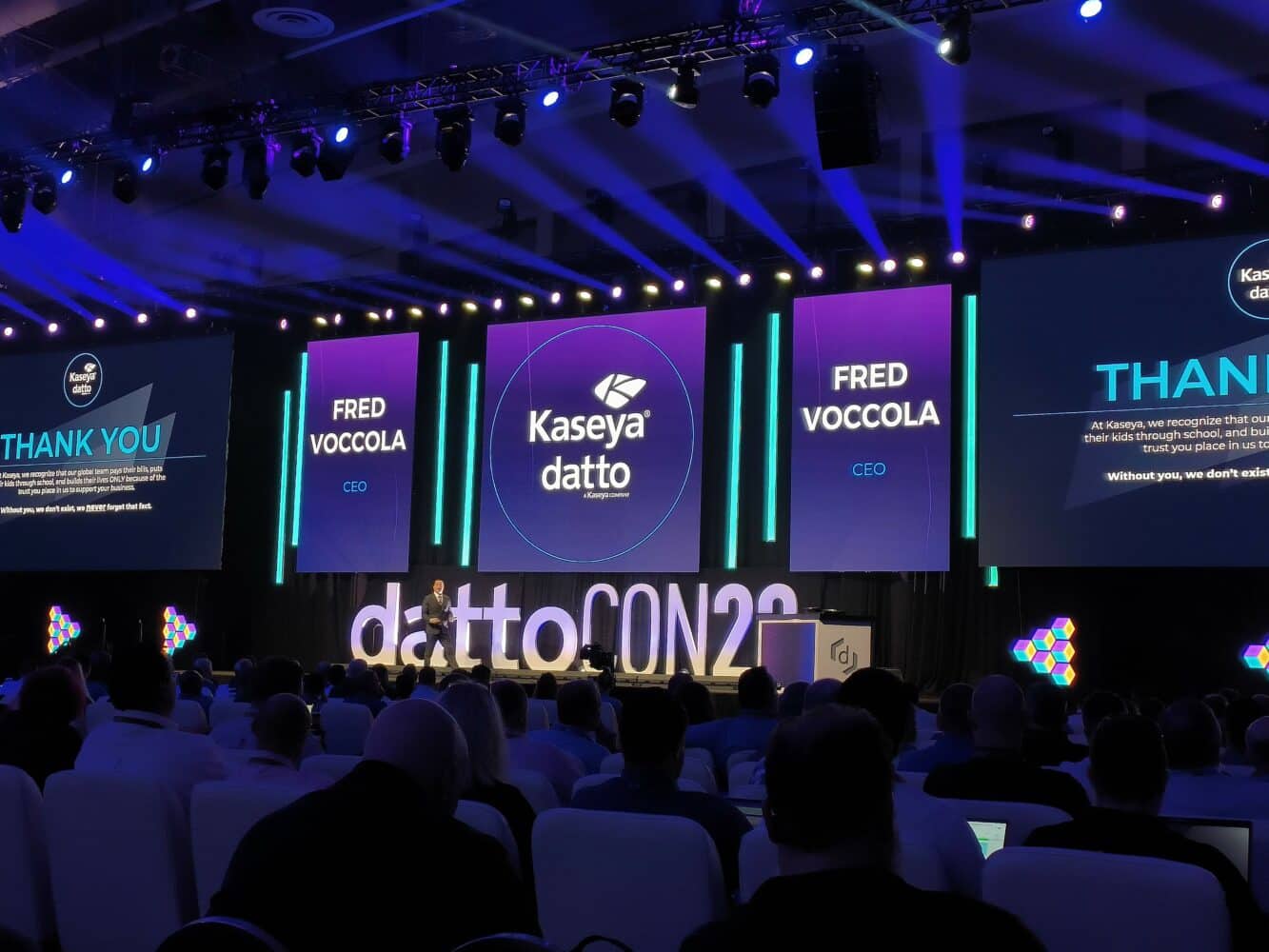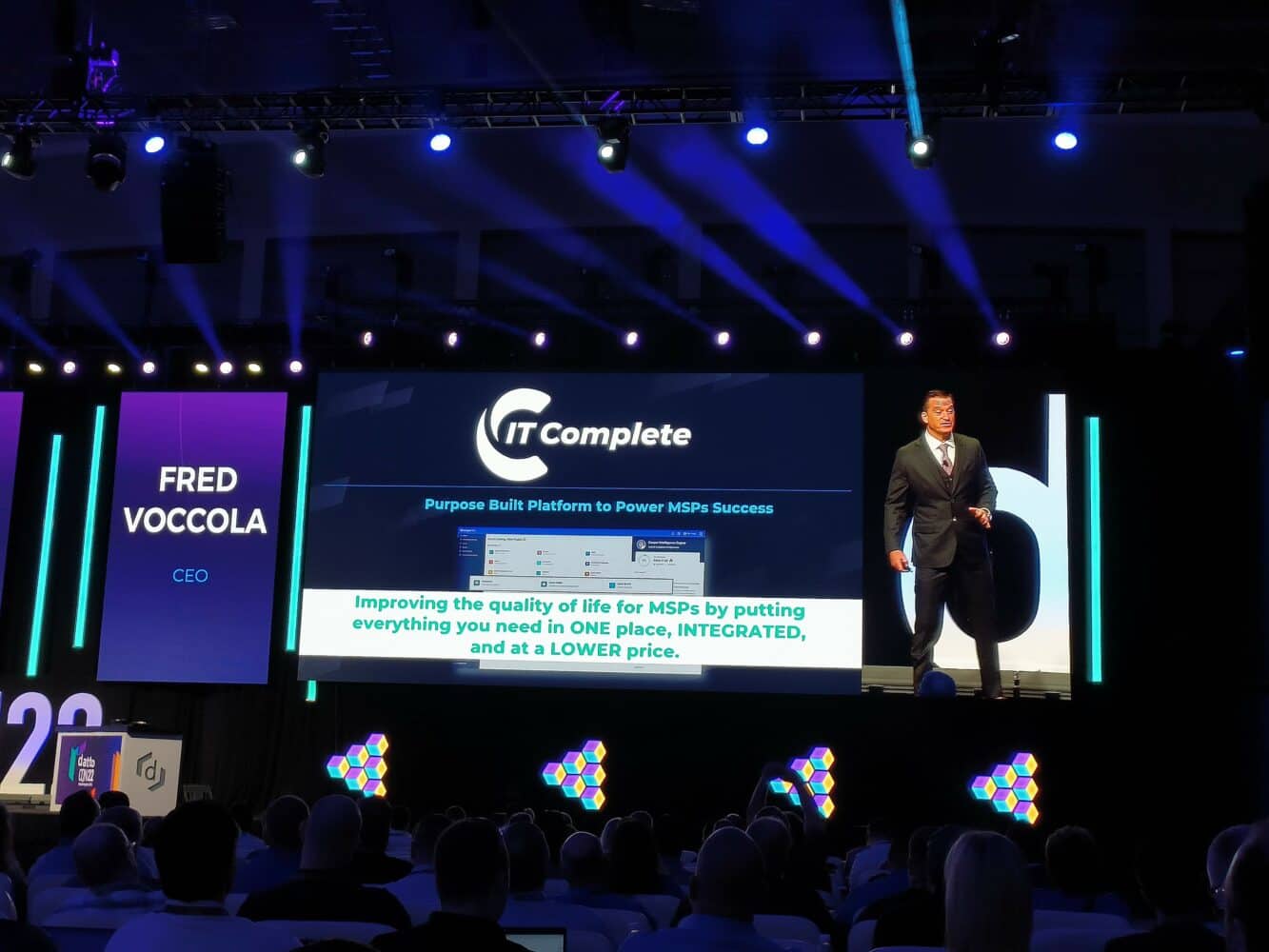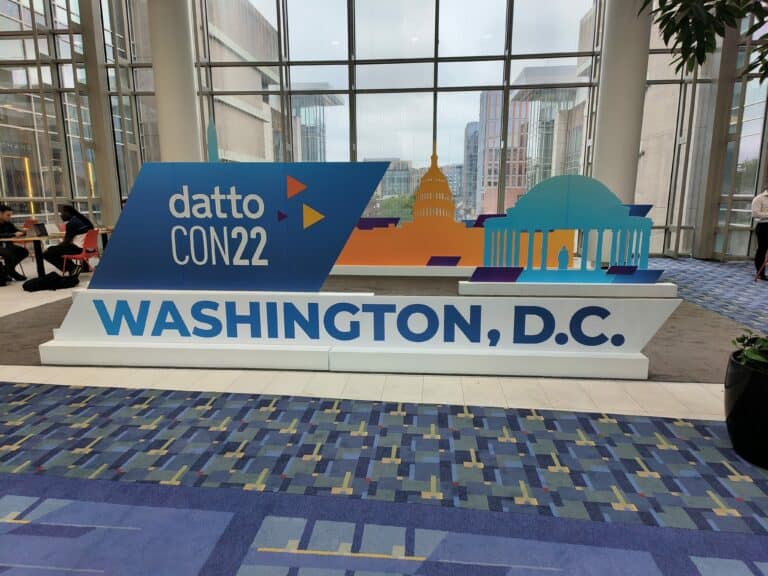It’s a good time to be an MSP, according to Kaseya CEO Fred Voccola. MSPs have many opportunities to grow. However, these opportunities also bring challenges. MSPs need to take a hard look at how they structure their services to customers. Kaseya’s IT Complete platform, into which Datto is now also being integrated step by step, should be able to help with this.
We attended DattoCon in Washington this week. Much has been said and written in recent months about Kaseya’ s acquisition of Datto earlier this year. Based on what we heard at DattoCon from both Kaseya and Datto employees, the latter’s integration into Kaseya’s platform and portfolio seems to be well on its way. We spoke briefly with Kaseya CEO Fred Voccola shortly before the conference to hear what the plans are and how he sees the market. In addition, of course, we attended the keynotes and spoke with Holly Pateman, SVP Product Marketing at Kaseya and Greg Jones, Business Development Director at Datto.
Investments in IT and cybersecurity rising fast
Kaseya and Datto focus largely on the MSP market. Datto does so entirely; at Kaseya, it’s a 50/50 ratio between MSP and midmarket organizations with a small IT team. Consequently, the main focus at DattoCon is on how MSPs can serve the market. However, according to Voccola, those are largely dependent on how much SMEs invest in IT and security. On that front, Voccola sees very strong growth, which is really only accelerating. He cites figures suggesting that these investments are growing four times faster than the GDP of the regions in which this was studied. In other words, investment is increasing at four times the economy.
A major reason for the rise in investment is that technology has become a lot more accessible. “Investing in technology used to be mainly something big companies and banks did, now technology has become mainstream,” he points out. That means it is also becoming easier to invest in it. Indeed, technology is increasingly seen as the best investment within companies, according to Voccola.
Of course, this development is not just driven by the greater accessibility of technology. Necessity plays an important role too. Covid has obviously played a role in this, but increased cyber threats are also driving organizations to invest more.
MSPs grow, but also face more competition
Whatever the ultimate reason for the surge in investments, the bottom line is that it’s good news for MSPs. After all, many SMEs don’t have the people to properly deploy and manage everything. For that, they turn to MSPs.
For MSPs, this undoubtedly means that they can and must grow. In other words, they need to mature. Voccola certainly sees that happening. Globally, he sees a sharp increase in the number of MSPs. In addition, individual MSPs are also making strides. To illustrate, he cites that today about thirty percent of MSPs have someone dedicated solely to marketing. About five years ago, that was only five percent.
The flip side of increased maturity for MSPs is that it brings new challenges. From an operational perspective, competition is increasing. After all, there are more and more of them entering the marketplace. Voccola sees this especially clearly when it comes to renewing contracts. Whereas before, as an MSP, you didn’t have to worry about your client going to someone else, now clients are shopping around a lot more to see if they can get a better deal somewhere else. The latter, by the way, also has to do with customers’ increased knowledge of what’s out there. The average customer today knows what ransomware is and what the cloud is. “The buyer is a little more educated these days,” as Voccola puts it.

Doing more with less
The main challenge for MSPs in the market, however, is not increased competition, Voccola argues. In fact, this should prove beneficial in the long run, as it encourages MSPs to improve their services. The big problem right now is that it is all getting too complex. Especially in the area of security, he sees this very clearly. “The average MSP today has seventeen different solutions to offer their customers,” he says. He also notes that more solutions do not automatically mean better security for customers. The important thing is to use them in the best possible way. With such a huge offering, it is very difficult to do that efficiently, Voccola believes.
MSPs need to become more efficient, is the point Voccola is trying to make here. This should also be done at a competitive price. For organizations, investments in IT and security are among the last to be cut. However, the increased competition for MSPs and the economic situation we are in globally mean it should not become too expensive for customers. In other words, MSPs face the challenge of doing more than ever before but delivering it at the lowest possible investment.
Datto acquisition
A central theme in everything Kaseya has done in recent years in terms of acquisitions has been to create that desired additional efficiency for MSPs and others. The acquisition of Datto earlier this year was also done with this in mind. Voccola is clearly a big fan of Datto. He is particularly impressed with Datto’s BCDR (Business Continuity and Disaster Recovery) solution, which he calls “the best in the world” for its target audience. According to Voccola, Kaseya already has the best solution in BCDR for very high-end (read: large numbers of petabytes) environments. That came with the acquisition of Unitrends several years ago. Datto BCDR targets the rest of the business market.
In addition to Datto BCDR, Datto Networking also stands out, according to Voccola. He calls it Datto’s “hidden gem”. That’s probably not what Datto itself thought, as it was about to retire that division. At Kaseya, however, they look at this differently. Customers (of MSPs) always need network infrastructure. Then it’s convenient if the MSP or Kaseya can provide it right away.
Voccola also notes that MSPs are not high on the list of priorities for network vendors such as Cisco. Those players focus primarily on enterprise environments anyway, according to him. The MSP is an afterthought for them, as Voccola puts it. We do see a shift happening at this point, by the way. With the rise of cloud-managed environments and, for example, Cisco’s recent integration of Meraki and Catalyst, those offerings are undoubtedly becoming more interesting to SMEs and the MSPs that serve this market.
Datto’s RMM (Remote Management and Monitoring) solution is also very good, Voccola points out. Here, however, a potential conflict arises for Kaseya. After all, it already has an RMM solution in its portfolio itself with VSA. So one of the questions Voccola has received the most since the acquisition was announced was whether they would get rid of one of the two. He wants to make very clear that Kaseya is not going to do that. The reason for this is simple. The company does not want to anger anyone unnecessarily. While keeping two RMM tools up and running may cost Kaseya about $20 million, driving customers away is going to cost much more in the long run, is his reasoning.
At the end of the day, Voccola says the Datto acquisition is about combining the best parts of both parties. A result of this, according to Greg Jones, should be the availability of more enterprise-grade technology for SMEs. This includes not only the tech stack, but also things like Datto’s excellent support organization, according to Voccola. Combining the best parts of different companies also implies that some parts aren’t considered to be good, let alone be the best. It’s almost unavoidable that those parts will eventually be disposed of. With RMM, that’s not going to happen, as we’ve seen above. We find it hard to imagine that this is and will remain true for all parts of the various vendors Kaseya has acquired.
Datto integration into Kaseya IT Complete
During his keynote at DattoCon, Voccola discusses integrations at length. He divides these into cosmetic integrations and workflow integrations. The former are the standard integrations (via APIs or otherwise) between tools from different vendors. While these yield reasonable gains in terms of efficiency of the entire environment, these gains are dwarfed by those of workflow integrations. That kind of integration involves integrations below the API level. Where you intertwine the tools that are part of a platform below the surface.
This is not to say that customers have to purchase all of the intertwined tools, by the way. It’s perfectly possible to pick only the ones you need, and still have a good user experience. Of course, being able to offer workflow integrations, also makes it easier for MSPs to market their services to customers. Because this way, the MSP only has to deal with one platform. For both Kaseya and MSPs, this means that costs can be kept relatively low, because work can be done relatively efficiently.
Workflow integrations are basically always better than cosmetic integrations, is the message Voccola wants to convey. Whether Kaseya’s partners in attendance were happy with this part of the keynote remains to be seen. Kaseya has cosmetic integrations with those, many of whom also offer solutions that Kaseya itself has in its portfolio. For workflow integrations, according to Voccola, Kaseya must first have the technology in-house. You can’t do these integrations with technology you don’t own, is his view. This view strongly drives Kaseya’s M&A strategy. It has made quite a few acquisitions in recent years. RapidFire, IT Glue, Unitrends, RocketCyber and now Datto are a few examples.

Making IT Complete as efficient and powerful as possible
The purpose of all these acquisitions is clear. Kaseya wants to make the IT Complete platform as powerful as possible, with deep workflow integrations between the various components. That way, the company wants to reduce the seventeen tools an MSP now uses to one. This will bring about a major simplification effort and with it a sharp increase in efficiency.
These kinds of stories sound very good; ultimately, however, Kaseya has to actually deliver on its promises too. On that front, the company seems to be putting its money where its mouth is. Voccola talks about twenty-five integrations with Datto per quarter, a number also mentioned by Holly Pateman when we speak to her. One of the most notable integrations so far, she says, is the integration between Datto BCDR and IT Glue, a piece of IT documentation software. In addition, she also indicates that at least as many integrations are being added each quarter within the existing Kaseya offering. So there is plenty to gain there as well.
Talking about integrations very quickly leads to talking about automation. It’s no surprise, then, that Greg Jones calls automation a primary focus for Kaseya/Datto. “We need to make sure that MSPs use our technology to really make automation work,” he points out. Only then can you also become more efficient, reduce costs and do more with fewer people. Within a single powerful platform, in theory at least, this also works better than having to work with the seventeen different tools mentioned above.
Strong focus on security
When we ask Pateman and Jones what the most emphasis will be on in the near future, they don’t have to think long about it. That – besides doubling MDF funds – is cybersecurity. For this, they cite more or less the same observation we saw earlier with network infrastructure. In their view, most existing solutions are not necessarily aimed at MSPs and SMEs. This while there is increasing pressure on MSPs from customers to do something with and about this.
During DattoCon, no fewer than three new security offerings were announced: Datto Managed SOC (based on RocketCyber), Datto EDR and Datto Secure Edge, a SASE solution. When we hear that Datto EDR is coming, we are immediately reminded of an interview we had with Voccola just under four years ago. In it, he indicated that he did not see Kaseya doing anything in the area of endpoint security anytime soon. In and of itself, that statement may still stand, since this is Datto EDR, not Kaseya EDR. However, as far as we are concerned, it also indicates that a lot has changed in four years. And that it is not so easy to pinpoint everything exactly.
In the middle of the sweet spot
Kaseya’s overarching vision, including when it comes to the Datto acquisition, will remain solid towards the future. That vision is to keep building out the IT Complete platform to allow MSPs in particular to work as efficiently as possible. Most acquisitions provide additional technology that Kaseya can use to strengthen existing components. Consider Datto’s BCDR and RMM components. Sometimes, however, this also means adding something completely new. Datto Networking is a good example of this. In this way, Kaseya wants to stay relevant and become increasingly relevant to MSPs and small IT teams at SME’s. The low cost is also an important differentiating factor here.
The overarching message of DattoCon is clear. Pateman articulates this in our conversation as follows: “At the end of the day, we [Kaseya, ed.] are in the middle of the sweet spot, the demand for security and IT will only go up.” Jones says more or less the same thing when he states that it is a “very exciting time to be an MSP.” However, this great position also comes with its challenges. That’s where Kaseya’s technology will have to come up with answers. With the acquisition of Datto, if all goes well, that answer has become a little more comprehensive than it already was.
